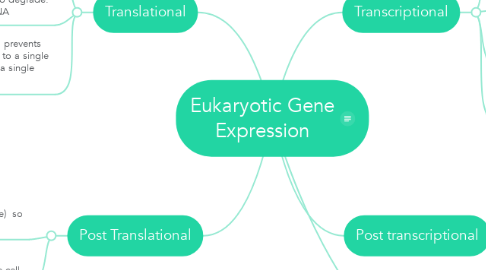Eukaryotic Gene Expression
by Jack Allen

1. Translational
1.1. IRNA is the process by which the gene expression is regulated during translation
1.2. miRNA matches up to mRNA and prevents translation or causes the mRNA to degrade. miRNA is more versitile than siRNA
1.3. siRNA also matches up with mRNA and prevents transcription. However this fit is specific to a single base pair order, and can only attach to a single strand.
1.3.1. This entire process prevents translation from occurring because the protein factors needed for translation are usually used.
2. Post Translational
2.1. Proteins are marked with ubiquitin(a small protein found in almost every human tissue) so that they can be recognized.
2.2. Proteasome then breaks down the marked protein, and the peptides are reused by the cell.
3. These mechanisms are responsible for regulating mRNA once it has been produced.
4. Transcriptional
4.1. These three events have the ability to either promote or inhibit transcription.
4.2. Phosphorylation- causes genes that have been methylated to be read
4.3. Methylation-causes the chromatin to condense, and results in the chromatin not being read, this is the idea behind epigenetics
4.4. Histone acetylation-occurs when acetyl groups bind to the histones, thus promoting transcription
5. Post transcriptional
5.1. RNA splicing occurs when the introns are removed from mRNA during processing, this results in changed proteins and polypeptides.
5.2. mRNA degradation is when the mRNA is broken down. This occurs when the mRNA and the product it translates are no longer needed.
5.3. Initiation of translation is where regulatory proteins bind to the 5' untranslated region(UTR). By doing this, ribosomes cannot attach to anything and in turn, translation cannot take place either.



